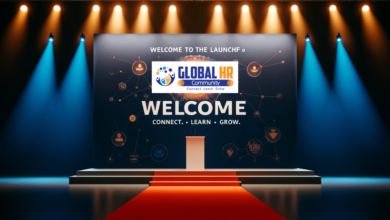
By | Editor
Inspired by Dave Ulrich I had written an article HR Roles – Fast Forward, which evinced a lot of interests of many readers. In one of the changing roles, I had indicated that HR has to move from being a Change Agent to become a Paradox Navigator.
What are some of the HR Paradoxes and how should HR learn to navigate them
In the ever-evolving landscape of today’s workplaces, the role of the HR leader has evolved into one of remarkable complexity. The modern HR leader, often regarded as the linchpin of organizational success, faces the formidable task of navigating a multitude of paradoxes while meticulously balancing conflicting priorities. This challenge is emblematic of the dynamic nature of contemporary businesses, where adaptability and strategic prowess are paramount.
A pioneer who has shed light on this intricate web of HR challenges is Dave Ulrich a venerable HR Thought Leader and HR Guru, in the realm of human resources. In his article Why and How Business and HR Leaders Navigate Paradox, he has pioneered his insights, and has unraveled the intricacies of this complex reality, providing a compass for HR leaders to chart their course amidst the paradoxes that define the modern workplace.
We will explore these paradoxes and how HR leaders, inspired by Dave Ulrich wisdom, skillfully negotiate them to steer their organizations towards success.
- Serving Business & Employees vs. Customers
Traditionally, HR departments focused primarily on serving the interests of the employees within the organization. However, the modern HR leader faces the paradox of serving both employees and customers, often with conflicting demands. On one hand, HR must create a positive employee experience to attract and retain talent, while on the other hand, it must align with the business strategy to meet customer needs.
Example: Consider an e-commerce company. To serve the business and employees, HR may focus on streamlining warehouse operations and reducing labor costs. However, to meet customer expectations, they must also ensure that the warehouse staff is well-trained, motivated, and efficient in handling orders. This balancing act involves optimizing workforce management to keep costs in check while delivering a seamless customer experience.
2. Command & Control vs. Care, Compassion & Empowerment
Historically, organizations embraced a command and control approach to management, but today’s workforce values care, compassion, and empowerment. HR leaders must navigate this paradox by fostering a culture of trust, autonomy, and empathy while still ensuring accountability and performance.
Example: In a healthcare organization, HR faces the challenge of balancing the need for command and control with care, compassion, and empowerment. They must establish strict protocols and guidelines for patient care to ensure safety and compliance. However, they also encourage nurses and caregivers to make critical decisions in real-time to provide personalized care, emphasizing empathy and compassion for patients and their families.
3. Flexibility vs. Conformity (Work from Anywhere vs. Work from Office)
The COVID-19 pandemic accelerated the adoption of remote work, challenging the traditional office-centric model. HR leaders now must navigate the tension between offering flexibility for employees to work from anywhere and maintaining the benefits of in-person collaboration and company culture.
Example: Consider a tech startup that embraces flexible work arrangements. HR allows employees to work from anywhere to promote work-life balance. However, for certain roles like software development or hardware testing, employees are encouraged to work from the office to facilitate collaboration and access to specialized equipment. HR must balance the desire for flexibility with the need for in-person interaction and resources.
4. Flat Structure vs. Hierarchy
Flat organizational structures promote agility and collaboration, while hierarchies provide clear reporting lines and accountability. HR leaders need to balance the benefits of a flat structure with the need for hierarchy in larger organizations.
Example: In a design agency, HR may implement a flat organizational structure to promote creativity and innovation. Cross-functional teams collaborate seamlessly, and decision-making is shared. However, HR maintains a hierarchical structure for administrative functions like finance and legal to ensure clear reporting lines and compliance with industry regulations.
5. Centralized vs. Decentralized
Centralized HR functions offer consistency and control, whereas decentralized functions allow for customization and responsiveness. HR leaders must decide how to strike the right balance between these two approaches.
Example: A multinational corporation centralizes HR functions like payroll and benefits administration to ensure uniformity and efficiency across various locations. However, they decentralize recruitment and employee development to regional HR teams to tailor strategies to local talent pools and cultural nuances.
6. Employee Experience vs. Customer Experience
HR leaders often confront the paradox of prioritizing employee experience and customer experience. A happy and engaged workforce can lead to improved customer satisfaction, but investments in customer experience may come at the expense of employee well-being.
Example: In a luxury hotel chain, HR invests in the employee experience by providing extensive training, competitive benefits, and career development opportunities. This creates a workforce that can deliver exceptional service, aligning with the brand’s commitment to a top-notch customer experience. Simultaneously, HR collaborates with the marketing team to understand and fulfill guest expectations.
7. Agile vs. Fixed
The HR function needs to be agile in responding to rapidly changing business environments, yet it also requires a degree of fixed processes and policies to maintain consistency and compliance.
Example: A software development company employs agile methodologies to adapt quickly to changing market demands. HR supports this by enabling flexible work arrangements, allowing employees to pivot their focus as needed. However, HR maintains fixed policies regarding data security and compliance, ensuring that the company adheres to regulatory requirements.
8. Full-time Employees vs. Contingent Workforce
HR leaders face the challenge of balancing the benefits of a full-time, permanent workforce with the flexibility and cost savings offered by contingent workers such as freelancers, contractors, and gig workers.
Example: A marketing agency maintains a core team of full-time employees responsible for long-term client relationships and strategy. However, during peak campaign seasons, they tap into a contingent workforce of freelance designers and writers to meet the increased demand for creative content. This approach balances stability with scalability.
9. Inside Out vs. Outside In Approach
Traditionally, HR was often inward-focused, with a tendency to operate in isolation from external factors. Sometimes, HR functioned like an ostrich burying its head in the sand, ignoring external realities. Dave Ulrich has championed the shift towards an outside-in approach, emphasizing the importance of HR understanding and responding to external market dynamics, customer expectations, and industry trends.
Example: An HR leader, adopting an outside-in approach, actively gathers market intelligence and customer feedback through collaboration with the sales and marketing teams. They use this external information to shape their talent acquisition strategy. For instance, if customers express a preference for personalized customer service, HR seeks candidates with strong interpersonal skills to enhance the customer experience.
10. Build vs. Buy in Talent Acquisition, Management, and Development:
The “Build vs. Buy” paradox is a fundamental challenge that HR leaders face when it comes to talent. It revolves around the decision of whether to build and develop talent internally or buy (i.e., hire externally) the required skills and expertise. Striking the right balance between these approaches is crucial for HR’s success.
Example : For TechSolutions Inc., the “Build vs. Buy” paradox is a critical HR challenge. The company adopts a “build” approach by nurturing talent from within, providing structured career development plans, and promoting a culture of continuous learning. This empowers employees to grow and advance internally. Simultaneously, TechSolutions Inc. employs a “buy” approach when specific skills or expertise are needed, seeking external candidates or even acquiring specialized teams or startups. This strategic balance allows the company to harness both internal growth and external expertise, ensuring it remains adaptable and competitive in a dynamic industry.
These examples have illuminated the intricate web of paradoxes that modern HR leaders must navigate. From serving the interests of both employees and customers to balancing flexibility with conformity, these paradoxes are an inherent part of the contemporary workplace. Successful HR leaders are those who can strike the right balance, adapt to changing circumstances, and champion the best interests of both their organization and their workforce.
As the business landscape continues to evolve, the ability to manage these paradoxes, coupled with an outside-in approach, will be a defining characteristic of effective HR leadership. HR leaders who can embrace these challenges will not only drive the success of their organizations but also shape the future of work.
Republished with permission and originally published at Ramesh Ranjan‘s LinkedIn






